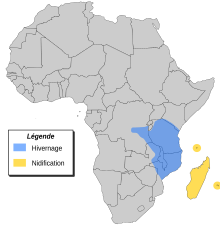Thick-billed heron
| Thick-billed heron | ||||||||||||
|---|---|---|---|---|---|---|---|---|---|---|---|---|

Thick-billed heron ( Ardeola idae ) |
||||||||||||
| Systematics | ||||||||||||
|
||||||||||||
| Scientific name | ||||||||||||
| Ardeola idae | ||||||||||||
| ( Hartlaub , 1860) |
The thick-billed heron ( Ardeola idae ) is a species of the heron family , which belongs to the genus of the pint-free heron . It is one of the particularly threatened heron species. Its breeding area is Madagascar , outside of the breeding season it also occurs in East Africa.
Appearance
Like all pint-free herons, it is a relatively small species of heron. He reaches a body length between 45 and 48 centimeters. There is no gender dimorphism .
During the breeding season, its body plumage is pure white. The beak is blue and the legs are red. At the back of the head it has elongated feathers that form a tuft. Such elongated feathers are also found on the neck, back and chest. These give the thick-billed heron a fuzzy, fluffy appearance that is characteristic of this species.
When resting, the thick-billed heron is very similar to the black-tailed heron and can hardly be distinguished from it in field observations. Outside the breeding season, the top and back of the head are ocher with wide black stripes. The beak is gray-green and only turns black towards the tip. The iris is yellow. The sides of the head and throat are yellow-brown with narrow brown-black stripes. The back is dark brown with whitish or yellow-brown stripes. The trunk and tail are white. The wings, on the other hand, are white, so that there is a striking contrast in the flight image. Young birds resemble the adult birds in their resting plumage. However, the outer wings and the tail are still dark brown-gray, which is particularly noticeable in flight. The beak is pale orange.
Distribution area and existence
The thick-billed heron only breeds in Madagascar and on Aldabra . Outside of the breeding season, it is also found in Central and East Africa. In Madagascar, its breeding occurrences are now limited to the west of the island. There are still larger breeding populations in the Antananarivo region .
He spends most of the winter in Tanzania and Kenya . There are also sightings for Uganda , Rwanda , Burundi , Zambia , Congo, northeast Mozambique , the Comoros and the Seychelles . The train to Africa starts in May. The thick-billed herons return to Africa in October. Individual thick-billed herons also overwinter in Africa and individuals who are not yet able to reproduce sometimes remain in the wintering areas during their first year of life.
The breeding population has steadily declined over the past few decades. The thick-billed heron was still common in Madagascar in the 1940s and brooded across the island. Colonies that used to have more than 700 breeding pairs now only consist of a few dozen pairs.
Habitat and way of life
The big-billed egret's habitat are small grass marshes, small lakes and ponds, streams, ditches and rice fields. It is evidently pointed to the immediate proximity of trees and bushes to the water surface, which is not the case for other heron species in this form. Its habitat is increasingly being lost through clearing and draining. The conversion of marshland into rice fields also has a negative impact on the population of this species. Unlike the black heron, it does not adapt very well to cultivated rice fields. Like all other herons, the thick-billed heron is hunted in Madagascar.
The big-billed heron seeks its food individually. He stands at the edge of the water or in shallow water or walks very slowly from his food territory. Its food spectrum includes frogs, fish and small lizards as well as insects.
Reproduction
The breeding season falls in the beginning of the rainy season in Madagascar. The nest is built in trees or bushes. It is a colony breeder that can form colonies of more than 1,000 pairs together with the black heron. In such a mixed colony, the thick-billed egret's nests are usually found above those of the black-tailed heron. The clutch usually consists of three to four eggs. The laying interval is up to three days. Occasionally, there are secondary locations from February to March. The breeding season begins when the last egg is deposited and lasts about 20 days. Both parent birds breed.
supporting documents
Single receipts
literature
- James A. Kushlan & James A. Hancock: Herons . Oxford University Press, 2005, ISBN 0-19-854981-4
Web links
- BirdLife factsheet about the big-billed heron , accessed September 10, 2009
- Ardeola idae inthe IUCN Red List of Threatened Species 2013.1. Listed by: BirdLife International, 2012. Retrieved November 21, 2013.
